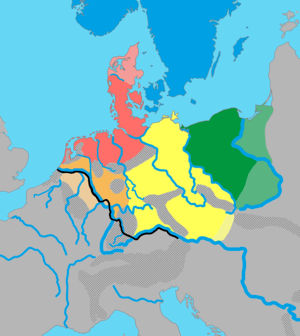Irminones
| Irminones | |
|---|---|
| Geographic distribution | Originally the North Sea coast from Friesland to Jutland |
| Linguistic classification |
Indo-European
|
| Subdivisions | |
| Glottolog |
high1286 (High German)[1] high1287 (High Franconian)[2] |
 The distribution of the primary Germanic dialect groups in Europe in around AD 1:
Elbe Germanic, or Irminonic
| |
The Irminones, also referred to as Herminones or Hermiones (Ancient Greek: Ἑρμίονες), were a large group of early Germanic tribes settling in the Elbe watershed and by the 1st century AD expanding into Bavaria, Swabia and Bohemia. Notably this included the large sub-group of the Suevi, that itself contained many different tribal groups, but the Irminones also for example included the Chatti.
Irminonic or Elbe Germanic is also therefore a term for one of the unattested dialect groups ancestral to the West Germanic language family, especially the High German languages,[3] which include modern Standard German.
History
The name Irminones or Hermiones comes from Tacitus's Germania (AD 98), where he categorized them as one of the tribes of descended from Mannus, and noted that they lived in the interior of Germany. Other Germanic groups of tribes were the Ingvaeones, living on the coast, and Istvaeones, who accounted for the rest.[4] Tacitus also mentioned the Suebi as a large grouping who included the Semnones, the Quadi and the Marcomanni, but he did not say precisely to which (if any) of the three nations they belonged.
Pomponius Mela wrote in his Description of the World (III.3.31) in reference to the Kattegat and the waters surrounding the Danish isles (see the Codanus sinus): "On the bay are the Cimbri and the Teutoni; farther on, the farthest people of Germania, the Hermiones." Mela then begins to speak of the Scythians.
Pliny's Natural History (4.100) claimed that the Irminones included the Suebi, Hermunduri, Chatti, and Cherusci.
In Nennius, the name Mannus and his three sons appear in corrupted form, the ancestor of the Irminones appearing as Armenon. His sons here are Gothus, Valagothus/Balagothus, Cibidus, Burgundus, and Longobardus, whence come the Goths (and Ostrogoths, Visigoths, Crimean Goths), Valagoths/Balagoths, Cibidi, Burgundians, and Langobards.
They may have differentiated into the tribes Alamanni, Hermunduri, Marcomanni, Quadi, Suebi by the first century AD. By that time the Suebi, Marcomanni and Quadi had moved southwest into the area of modern-day Bavaria and Swabia. In 8 BC, the Marcomanni and Quadi drove the Boii out of Bohemia.
The term Suebi is usually applied to all the groups that moved into this area, though later in history (around 200 AD) the term Alamanni (meaning "all-men") became more commonly applied to the group.
Jǫrmun, the Viking Age Norse form of the name Irmin, can be found in a number of places in the Poetic Edda as a by-name for Odin. Some aspects of the Irminones' culture and beliefs may be inferred from their relationships with the Roman Empire, from Widukind's confusion over whether Irmin was comparable to Mars or Hermes, and from Snorri Sturluson's allusions, at the beginning of the Prose Edda, to Odin's cult having appeared first in Germany, and then having spread up into the Ingvaeonic North.
Notes
- ↑ Hammarström, Harald; Forkel, Robert; Haspelmath, Martin, eds. (2017). "High German". Glottolog 3.0. Jena, Germany: Max Planck Institute for the Science of Human History.
- ↑ Hammarström, Harald; Forkel, Robert; Haspelmath, Martin, eds. (2017). "High Franconian". Glottolog 3.0. Jena, Germany: Max Planck Institute for the Science of Human History.
- ↑ Friedrich Maurer (1942), Nordgermanen und Alemannen: Studien zur Sprachgeschichte, Stammes- und Volkskunde, Strasbourg: Hünenburg.
- ↑ Alfred John Church, William Jackson Brodribb (eds.). "Cornelius Tacitus, Germany and its Tribes, chapter 2". www.perseus.tufts.edu. Retrieved 16 April 2018.
References
- Grimm, Jacob (1835). Deutsche Mythologie (German Mythology); From English released version Grimm's Teutonic Mythology (1888); Available online by Northvegr © 2004-2007:Chapter 15, page 2-; 3. File retrieved 09-26-2007.
- Tacitus, Germania (1st century AD). (in Latin)
- Friedrich Maurer (1942) Nordgermanen und Alemannen: Studien zur germanischen und frühdeutschen Sprachgeschichte, Stammes- und Volkskunde, Strasbourg: Hünenburg.